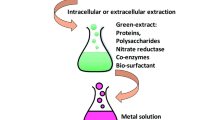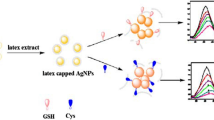Abstract
This paper presents the green synthesis of silver nanoparticles (AgNPs) using orange (Citrus sinensis) peel extract. The effects of different factors such as silver ion concentration, reaction time, temperature, pH, and extract quantity on the AgNPs synthesis were studied, enabling us to determine optimum synthesis conditions. We characterized the AgNPs with different techniques: UV–Visible Spectroscopy, Field Emission Scanning Electron Microscopy (FESEM), FTIR, and XRD. The AgNPs showed yellowish brown to golden brown colors and a surface plasmon resonance (SPR) absorption band around a wavelength of 420 nm. FESEM images showed polydisperse AgNPs having an average size of about 55 nm. The XRD profile of the synthesized nanoparticles showed peaks that are characteristic of silver while the FTIR spectrum highlighted the functional groups associated with reducing silver ions and stabilizing the AgNPs. With the selected optimum conditions, the AgNPs were formed in less than 1 min. This is the fastest reaction time so far reported and is significantly shorter than in earlier reports. The AgNPs colloid solution was applied as nanosensor in the visual colorimetric detection of mercury(II) ions in water. The golden brown AgNPs colloid solution turned colorless and the characteristic SPR absorption band disappeared when mercury(II) ions were added to the solution. While the AgNPs show good sensitivity and selectivity for the colorimetric detection of mercury(II) ions with a detection limit of 1.24 × 10−6 mol/L (0.25 ppm), we also demonstrated the suitability of the method for detecting mercury(II) ions in drinking water.








Similar content being viewed by others
References
Annadhasan, M.; Muthukumarasamyvel, T.; Sankar Babu, V.R.; Rajendiran, N.: Green synthesized silver and gold nanoparticles for colorimetric detection of Hg2+, Pb2+, and Mn2+ in aqueous medium. ACS Sustain. Chem. Eng. 2, 887–896 (2014)
Mohamed, M.B.; Volkov, V.; Link, S.; El-Sayed, M.A.: The ‘lightning’ gold nanorods: fluorescence enhancement of over a million compared to the gold metal. Chem. Phys. Lett. 317, 517–523 (2000)
Rai, M.; Gade, A.; Yadav, A.: Biogenic nanoparticles: an introduction to what they re, how they are synthesized and their applications in microbiology. In: Rai, M., Duran, N. (eds.) Metal Nanoparticles in Microbiology, pp. 1–14. Springer, Berlin (2011)
Saxena, A.; Tripathi, R.M.; Zafar, F.; Singh, P.: Green synthesis of silver nanoparticles using aqueous solution of Ficus benghalensis leaf extract and characterization of their antibacterial activity. Mater. Lett. 67, 91–94 (2012)
Yunus, I.S.; Harwin,; Kurniawan, A.; Adityawarman, D.; Indarto, A.: Nanotechnologies in water and air pollution treatment. Environ. Technol. Rev. 1, 136–148 (2012)
de Barros, C.H.N.; Cruz, G.C.F.; Mayrink, W.; Tasic, L.: Bio-based synthesis of silver nanoparticles from orange waste: effects of distinct biomolecule coatings on size, morphology, and antimicrobial activity. Nanotechnol. Sci. Appl. 11, 1–14 (2018)
Hemlata,; Meena, P.R.; Singh, A.P.; Tejavath, K.K.: Biosynthesis of silver nanoparticles using Cucumis prophetarum aqueous leaf extract and their antibacterial and antiproliferative activity against cancer cell lines. ACS Omega 5, 5520–5528 (2020)
Akhtar, M.S.; Panwar, J.; Yun, Y.-S.: Biogenic synthesis of metallic nanoparticles by plant extracts. ACS Sustain. Chem. Eng. 1, 591–602 (2013)
Park, Y.: A new paradigm shift for the green synthesis of antibacterial silver nanoparticles utilizing plant extract. Toxicol. Res. 30, 169–178 (2014)
Hembram, K.C.; Kumar, R.; Kandha, L.; Parhi, P.K.; Kundu, C.N.; Bindhani, B.K.: Therapeutic prospective of plant induced silver nanoparticles application as antimicrobial and anticancer agent. Artif. Cells Nanomed. Biotechnol. 46, S38–S51 (2018)
Zahir, F.; Rizwi, S.J.; Haq, S.K.; Khan, R.H.: Low dose mercury toxicity and human health. Environ. Toxicol. Pharmacol. 20, 351–360 (2005)
Holmes, P.; James, K.A.; Levy, L.S.: Is low-level environmental mercury exposure of concern to human health? Sci. Total Environ. 408, 171–182 (2009)
Yamini, Y.; Alizadeh, N.; Shamsipur, M.: Solid phase extraction and determination of ultra trace amounts of mercury(II) using octadecyl silica membrane disks modified by hexathia-18-crown-6-tetraone and cold vapour atomic absorption spectrometry. Anal. Chim. Acta 355, 69–74 (1997)
Kuswandi, B.; Nuriman, A.; Dam, H.H.; Reinhoudt, D.N.; Verboom, W.: Development of a disposable mercury ion-selective optode based on trityl-picolamide as ionophore. Anal. Chim. Acta 591, 208–213 (2007)
Fong, B.S.; Siu, T.S.; Lee, J.S.; Tam, S.: Determination of mercury in whole blood and urine by inductively coupled plasma mass spectrometry. J. Anal. Toxicol. 31, 281–287 (2007)
Ichinoki, S.; Kitahata, N.; Fujii, Y.: Selective determination of mercury(II) ion in water by solvent extraction followed by reversed-phase HPLC. J. Liq. Chromatogr. Relat. Technol. 27, 1785–1798 (2004)
Rastogi, L.; Sashidhar, R.B.; Karunasagar, D.; Arunachalam, J.: Gum kondagogu reduced/stabilized silver nanoparticles as direct colorimetric sensor for the sensitive detection of Hg2+ in aqueous system. Talanta 118, 111–117 (2014)
Stewart, M.E.; Anderton, C.R.; Thompson, L.B.; Maria, J.; Gray, S.K.; Rogers, J.A.; Nuzzo, R.G.: Nanostructured plasmonic sensors. Chem. Rev. 108, 494–521 (2008)
Yang, Y.-K.; Yook, K.-J.; Tae, J.: A rhodamine-based fluorescent and colorimetric chemodosimeter for the rapid detection of Hg2+ ions in aqueous media. J. Am. Chem. Soc. 127, 16760–16761 (2005)
Zhu, Z.; Su, Y.; Li, J.; Li, D.; Zhang, J.; Song, S.; Zhao, Y.; Li, G.; Fan, C.: Highly sensitive electrochemical sensor for mercury(II) ions by using a mercury-specific oligonucleotide probe and gold nanoparticle-based amplification. Anal. Chem. 81, 7660–7666 (2009)
Liu, J.; Lu, Y.: Rational design of turn-on allosteric DNAzyme catalytic beacons for aqueous mercury ions with ultrahigh sensitivity and selectivity. Angew. Chem. Int. Ed. 46, 7587–7590 (2007)
Lu, H.; Tang, Y.; Xu, W.; Zhang, D.; Wang, S.; Zhu, D.: Highly selective fluorescence detection for mercury(II) ions in aqueous solution using water soluble conjugated polyelectrolytes. Macromol. Rapid Commun. 29, 1467–1471 (2008)
Awual, M.R.; Hasan, M.M.; Eldesoky, G.E.; Khaleque, M.A.; Rahman, M.M.; Naushad, M.: Facile mercury detection and removal from aqueous media involving ligand impregnated conjugate nanomaterials. Chem. Eng. J. 290, 243–251 (2016)
Abbas, K.; Znad, H.; Awual, M.R.: A ligand anchored conjugate adsorbent for effective mercury(II) detection and removal from aqueous media. Chem. Eng. J. 334, 432–443 (2018)
Awual, M.R.: Novel nanocomposite materials for efficient and selective mercury ions capturing from wastewater. Chem. Eng. J. 307, 456–465 (2017)
Awual, M.R.: An efficient composite material for selective lead(II) monitoring and removal from wastewater. J. Environ. Chem. Eng. 7, 103807 (2019)
Awual, M.R.: A facile composite material for enhanced cadmium(II) ion capturing from wastewater. J. Environ. Chem. Eng. 7, 103378 (2019)
Awual, M.R.; Hasan, M.M.: A ligand based innovative composite material for selective lead(II) capturing from wastewater. J. Mol. Liq. 294, 111679 (2019)
Farhadi, F.; Forough, M.; Molaei, R.; Hajizadeh, S.; Rafipour, A.: Highly selective Hg2+ colorimetric sensor using green synthesized and unmodified silver nanoparticles. Sens. Actuators B. Chem. 161, 880–885 (2012)
Bothra, S.; Solanki, J.N.; Sahoo, S.K.: Functionalized silver nanoparticles as chemosensor for pH, Hg2+ and Fe3+ in aqueous medium. Sens. Actuators B. Chem. 188, 937–943 (2013)
Park, J.; Joo, J.; Kwon, S.G.; Jang, Y.; Hyeon, T.: Synthesis of monodisperse spherical nanocrystals. Angew. Chem. Int. Ed. 46, 4630–4660 (2007)
Khatoon, N.; Mazumder, J.A.; Sardar, M.: Biotechnological applications of green synthesized silver nanoparticles. J. Nanosci. Curr. Res. 2, 1000107 (2017)
Zaki, S.; El Kady, M.F.; Abd-El-Haleem, D.: Determination of the effective origin source for nanosilver particles produced by Escherichia coli strain S78 and its application as antimicrobial agent. Mater. Res. Bull. 47, 4286–4290 (2012)
Dubey, S.P.; Lahtinen, M.; Sillanpaa, M.: Tansy fruit mediated greener synthesis of silver and gold nanoparticles. Process Biochem. 45, 1065–1071 (2010)
Mock, J.J.; Barbic, M.; Smith, D.R.; Schultz, D.A.; Schultz, S.: Shape effects in plasmon resonance of individual colloidal silver nanoparticles. J. Chem. Phys. 116, 6755–6759 (2002)
Huang, J.; Li, Q.; Sun, D.; Lu, Y.; Su, Y.; Yang, X.; Wang, H.; Wang, Y.; Shao, W.; He, N.: Biosynthesis of silver and gold nanoparticles by novel sundried Cinnamomum camphora leaf. Nanotechnology 18, 105104 (2007)
Sathishkumar, M.; Sneha, K.; Yun, Y.-S.: Palladium nanocrystals synthesis using Curcuma longa tuber extract. Int. J. Mater. Sci. 4, 11–17 (2009)
Noruzi, M.; Zare, D.; Khoshnevisan, K.; Davoodi, D.: Rapid green synthesis of gold nanoparticles using Rosa hybrida petal extract at room temperature. Spectrochim. Acta A 79, 1461–1465 (2011)
Pimprikar, P.S.; Joshi, S.S.; Kumar, A.R.; Zinjarde, S.S.; Kulkarni, S.K.: Influence of biomass and gold salt concentration on nanoparticle synthesis by the tropical marine yeast Yarrowia lipolytica. Colloids Surf. B Biointerfaces 74, 309–316 (2009)
Alqadi, M.K.; Abo Noqtah, O.A.; Alzoubi, F.Y.; Alzouby, J.; Aljarrah, K.: pH effect on the aggregation of silver nanoparticles synthesized by chemical reduction. Mater. Sci. Pol. 32, 107–111 (2014)
Vanaja, M.; Annadurai, G.: Coleus aromaticus leaf extract mediated synthesis of silver nanoparticles and its bactericidal activity. Appl. Nanosci. 3, 217–223 (2012)
Khalil, M.M.H.; Ismail, E.H.; El-Baghdady, K.Z.; Mohamed, D.: Green synthesis of silver nanoparticles using olive leaf extract and its antibacterial activity. Arab. J. Chem. 7, 1131–1139 (2014)
Salawu, O.A.; Chanbasha, B.; Zafarullah, K.; Alsharaa, A.; Siddiqui, Z.: Biogenic synthesis of silver nanoparticles, study of the effect of physicochemical parameters and application as nanosensor in the colorimetric detection of Hg2+ in water. Int. J. Environ. Anal. Chem. 96, 776–788 (2016)
Ibrahim, H.M.M.: Green synthesis and characterization of silver nanoparticles using banana peel extract and their antimicrobial activity against representative microorganisms. J. Radiat. Res. Appl. Sci. 8, 265–275 (2015)
Makarov, V.V.; Love, A.J.; Sinitsyna, O.V.; Makarova, S.S.; Yaminsky, I.V.; Taliansky, M.E.; Kalinina, N.O.: “Green” nanotechnologies: synthesis of metal nanoparticles using plants. Acta Nat. 6, 35–44 (2014)
Ahmad, N.; Sharma, S.; Alam, M.K.; Singh, V.N.; Shamsi, S.F.; Mehta, B.R.; Fatma, A.: Rapid synthesis of silver nanoparticles using dried medicinal plant of basil. Colloids Surf. B Biointerfaces 81, 81–86 (2010)
Prathna, T.C.; Chandrasekaran, N.; Raichur, A.M.; Mukherjee, A.: Biomimetic synthesis of silver nanoparticles by Citrus limon (lemon) aqueous extract and theoretical prediction of particle size. Colloids Surf. B Biointerfaces 82, 152–159 (2011)
Fayaz, A.M.; Balaji, K.; Kalaichelvan, P.T.; Venkatesan, R.: Fungal based synthesis of silver nanoparticles-an effect of temperature on the size of particles. Colloids Surf B Biointerfaces 74, 123–126 (2009)
Jiang, J.; Manolache, S.; Lee Wong, A.C.; Denes, F.S.: Plasma enhanced deposition of silver nanoparticles onto polymer and metal surfaces for the generation of antimicrobial characteristics. J. Appl. Polym. Sci. 93, 1411–1422 (2004)
Peterson, A.L.: The Scherrer formula for X-ray particle size determination. Phys. Rev. 56, 978–982 (1939)
Gopinath, V.; MubarakAli, M.; Priyadarshini, S.; Priyadharsshini, N.M.; Thajudin, N.; Velusamy, P.: Biosynthesis of silver nanoparticles from Tribulus terrestris and its antimicrobial activity: a novel biological approach. Colloid Surf. B Biointerfaces 96, 69–74 (2012)
Dhand, V.; Soumya, L.; Bharadwaj, S.; Chakra, S.; Deepika, B.; Sreedhar, B.: Green synthesis of silver nanoparticles using Coffea arabica seed extract and its antibacterial activity. Mater. Sci. Eng. C 58, 36–43 (2016)
Henglein, A.: Small-particle research: physicochemical properties of extremely small colloidal metal and semiconductor particles. Chem. Rev. 89, 1861–1873 (1989)
de Cointet, C.; Mostafavi, M.; Khatouri, J.; Belloni, J.: Growth and reactivity of silver clusters in cyanide solution. J. Phys. Chem. B 101, 3512–3516 (1997)
Pradhan, N.; Pal, A.; Pal, T.: Silver nanoparticle catalyzed reduction of aromatic nitro compounds. Colloids Surf. A Physicochem. Eng. Asp. 196, 247–257 (2002)
Lee, K.H.; Shin, M.C.; Lee, J.Y.: A kinetic study of the silver–mercury contact reaction. J. Mater. Sci. 21, 2430–2434 (1986)
Acknowledgements
We thank the Department of Chemistry at King Fahd University of Petroleum and Minerals for providing the resources used for this work.
Author information
Authors and Affiliations
Corresponding author
Electronic supplementary material
Below is the link to the electronic supplementary material.
Rights and permissions
About this article
Cite this article
Aminu, A., Oladepo, S.A. Fast Orange Peel-Mediated Synthesis of Silver Nanoparticles and Use as Visual Colorimetric Sensor in the Selective Detection of Mercury(II) Ions. Arab J Sci Eng 46, 5477–5487 (2021). https://doi.org/10.1007/s13369-020-05030-3
Received:
Accepted:
Published:
Issue Date:
DOI: https://doi.org/10.1007/s13369-020-05030-3




